Last updated on May 28, 2020
Posted December 17, 2018
Ben Lesser, Master of Science Environmental Science and Policy Program edited by faculty advisor: Mary Ann McGarry
Did you Know?!
Many people think that because a site is designated as a State Forest that it is “protected”. This is not true! The land is indeed protected from private development. However, the land is still open for commercial harvest of timber resources by state and private enterprises. In fact, Livermore Falls State Forest is actually home to a wealth of timber resources! When I recently visited the site, I was able to identify over 10 different species in less than an hour, including Black Cherry, American Elm, Paper and Yellow Birch, and American Beech. Some of the species like Black cherry, do not have many commercial uses. However, other species present like Eastern Hemlock, Red Maple, Red Oak, and Eastern White Pine have many commercial uses, and are valuable resources for the towns of Holderness, Plymouth, and Campton.
The site is managed by New Hampshire Department of Fish and Game and the New Hampshire Department of Resources and Economic Development, Division of Parks and Recreation. The forest is maintained in a sustainable way. The site is available for commercial harvest, but the forest has not been used for commercial purposes since the late 1800’s. In the event that a contract is given that allows commercial harvest, the Department of Fish and Game only allows one percent of the forest per year to be harvested at a time. This allows 100 years of regrowth before the initial one per cent is recut.
Eastern White Pine
Eastern White Pine (or Pinus Strobus if we’re getting technical) can be found at Livermore Falls in abundance. It is the largest of the Northeastern conifers. Common uses for this tree are for construction, including boat building, for crates and boxes, and for carving of artisanal crafts.
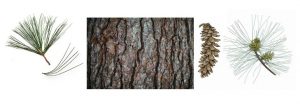
There are 3 keys to identifying this tree.
- Needles – They grow in bundles of 5. This number is important when identifying any coniferous tree. They grow to approximately between 6 and 10 cm and are distinctly straight.
- Bark – It is typically grayish-brown with deep, pronounced furrows. The ridges between the furrows are characteristically wide and rectangular, and can often appear to be topped with purplish scales.
- Cones – Staminate (When you are looking at this tree, the staminate cones are the heavy/dense ones that have yet to open) cones are approximately 10-15 mm in length, have a distinctive yellow/green hue, and are oval in shape. When the cones open (typically takes about 2 years) their color changes to a pale gray-brown. They can then grow to between 8 and 20 cm.
Eastern Hemlock
The dominant tree species at Livermore Falls is undoubtedly the Eastern Hemlock (Tsuga Canadensis). These trees typically grow to be about 40-70 feet tall. Like the Eastern White Pine, the lumber has an abundance of industrial uses. It is very commonly used for construction, firewood, and pulpwood- to produce paper products.
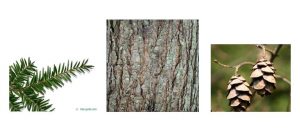
Once again: needles, bark, and cone characteristics are very helpful in identifying this tree.
- Needles – Unlike pines, hemlock trees have much shorter needles. The Eastern Hemlocks needles only grow to be about ½ inch long. The needles grow in 2 tight rows on opposite sides of the stem, with one of the rows slightly pointed upwards. They have a distinct “white” line that appears on the bottom of the needles.
- Bark – The bark is red-brown in color, as opposed to the grayer bark of the Eastern White Pine. The bark has a scaly appearance in its more juvenile years but develops furrows and ridges as the tree ages.
- Cones – The cones are small and abundant, typically growing to be about 1 inch long. The cones are light brown and they “open” less than other cones.
Red Oak
The dominant hardwoods at Livermore Falls State Forest include red oak. (Quercus Rubra), whichis very abundant at the site.. Its wood is significantly denser than pines and hemlocks, so its timber is used in different ways. Although it is still sometimes used as construction lumber, red oak is typically used in a more ornamental fashion, for furniture, cabinetry, flooring, and interior trim.

Deciduous trees do not have cones, so the leaves, bark, and acorn shape are the main identifying features.
- Leaves – Red oaks typically have between 7 and 11 lobes to each leaf. The lobes are toothed, as opposed to white oaks which have rounded lobes. Red oak leaves are deep green in the spring/summer months and have grayish-white bottoms. In autumn, they turn a brownish-red.
- Bark – Young red oaks have relatively smooth, light gray bark. As the trees age, the bark’s color darkens to a dark-grey, and it begins to develop furrows. The mature bark is typically identified by its plentiful flat-topped ridges. Furrows are more prominent towards the base of the tree, giving way to more pronounced ridges further up the trunk.
- Acorns – The acorns are differentiated by their distinctively flat cap that is thin, and doesn’t encompass more than ¼ of the nut. White oak acorns have a deeper cap and a slightly lighter color. Red oak acorns are typically around 1 inch or smaller in length.
Red Maple
The Red maple (Acer rubrum) produces very sought-after timber. Like red oak, Acer rubrum is often used for furniture, cabinetry, flooring, and interior trim. However, it is also very popular in the production of woodwind instruments, adding to its value. The wood is also still used as construction lumber in some cases as well.
Similar to red oak, its leaves and bark are essential in its identification. . Maple trees don’t have acorns OR cones, instead they have samaras (commonly known as seed helicopters).

- Leaves – If you need a good example of this leaf’s typical appearance, visualize the Canadian Flag. Although the flag does not exactly portray the red maple leaf. Red maple leaves have between 3 and 5 lobes depending on the age of the tree. The lobes are toothed, much like a Red Oak, and the stalks of the leaves are red. This is the most spectacular tree to view in autumn, as it produces a beautifully vibrant array of colors as the green leaves turn yellow, orange, and red.
- Bark – Similar to the red oak and most other trees, this tree’s bark changes as it grows. Young trees have a smooth, gray bark. The mature trees’ bark is dark-gray in color, and have a vast array of vertically oriented scaly-plates.
- Samaras – The seed pairs are typically red-brown in coloration. They are about an inch wide, and when dropped appear as mini “helicopters” twirling to the ground.
Why Do We Care?!
Since the Livermore Falls site is designated as a “State Forest”, any money earned by the state off of the timber would be immediately cycled back into the state. This could come contribute to the budget to improve infrastructure throughout the state, or perhaps in increased funding for public schools.
as Although New Hampshire remains largely forested, deforestation is breaking records every year. In 2016, a new record was set as 29.7 million acres of forest were cut globally. For those of us who are not spatially inclined, that is roughly the area of New Zealand. Forests such as at Livermore Falls have many benefits in addition to revenue which could be generated from sales of timber. Our forests are our planet’s primary source of respiration. Certain species of trees can absorb up to 48 lbs. of CO2 per year! In fact, an acre of forest can absorb the amount of CO2 a car travelling 26,000 miles in a given year. At 178.34 acres, Livermore Falls State Forest could absorb the CO2 produced by 4,628,000 miles of car travel annually!
Trees do even more than sequester carbon dioxide. Forests also mitigate the effects of rising temperatures. Differences of up to 19 degrees Fahrenheit have been found between forests and adjacent cleared land. Forests also supply food for animal populations as well as recharge groundwater supplies and sustain stream flow in times of drought. Forests next to rivers like at Livermore Falls also serve as buffers protecting water quality for aquatic organisms.
There are threats to the benefits that forests lands provide, including at Livermore Falls. The bulk of the forest that is found on higher ground, above the riparian zone, at Livermore Falls is comprised of Eastern Hemlocks. Out of all of the trees in North America, this tree is the most threatened. An invasive species, the Hemlock Woolly Adelgid (HWD), is running rampant across virtually the entire length of the Appalachian mountain range. The HWD lays up to 200 eggs per liter. The hatchlings then feed on the tree’s stored starches until they are depleted. At this point the tree doesn’t have enough stored energy to survive, and the HWD finds a new host. We need be aware of the HWD and how to identify an infestation to preserve the forest at Livermore Falls, part of the rich collection of environmental and cultural resources.
The Hemlock Woolly Adelgid gets its name from the appearance it takes on while taking over a hemlock. As you can see from the picture above, it looks as if a fresh snow has just fallen. These clusters are typically found on the underside of branches and needles, so look up! If we collectively strive to maintain the health and wellbeing of Livermore Falls State Forest, it will continue to maintain ours.

New Hampshire has an action plan to restrict the spread and manage Hemlock Woolly Adelgid within the state, revised in March of 2015. The plan was developed by the NH Division of Forests and Lands within guidance from the Forest Pest Advisory Group which is comprised of specialists from a number of organizations- the NH Department of Agriculture Markets and Foods, UNH Cooperative Extension, The Society for the Protection of NH Forests, the Nature Conservancy, the Granite State Society of American Foresters, and the USDA Animal Plant Health Inspection Service. The insect is spread by wind and wildlife naturally, so we must watch for the HWA presence at Livermore Falls site. Resource about the pests and what to do if you spot an infestation can be found at a New Hampshire state website: https://nhbugs.org/hemlock-woolly-adelgid.
References:
Action Plan To Restrict The Spread And Manage Hemlock Woolly Adelgid Within The State of New Hampshire, 2015, https://www.nhdfl.org/DRED/media/Documents/HWA-action-plan-15.pdf.
The Morton Arboretum, Red Maple. 2018. Retrieved October 19, 2018. http://www.mortonarb.org/trees-plants/tree-plant-descriptions/red-maple
The Morton Arboretum, Northern Red Oak. 2018. Retrieved October 19, 2018. http://www.mortonarb.org/trees-plants/tree-plant-descriptions/northern-red-oak
The Morton Arboretum, Eastern Hemlock. 2018. Retrieved October 20, 2018. http://www.mortonarb.org/trees-plants/tree-plant-descriptions/eastern-hemlock
Earle, Christopher J., Pinus Strobus. 2018. Retrieved October 20, 2018. https://www.conifers.org/pi/Pinus_strobus.php
New York State Department of Environmental Conservation, Hemlock Woolly Adelgid. 2018. Retrieved October 21, 2018. https://www.dec.ny.gov/animals/7250.html
Weisse, Mikaela, & Goldman, Elizabeth D., Global Tree Cover Loss Rose 51% in 2016. October 23, 2017. Retrieved October 30, 2018. https://www.wri.org/blog/2017/10/global-tree-cover-loss-rose-51-percent-2016
Gray & Pape, Inc., Cultural Landscape Report and Environmental Assessment Livermore Falls, Grafton County, New Hampshire. December 22, 2015. Retrieved November 8, 2018.Posted in Uncategorized
Going With The Flow At Livermore Falls
Going With The Flow At Livermore Falls
Owen Ginty, edited by Mary Ann McGarry
When students at Plymouth State think about Livermore Falls many of us may associate it as a place to swim with friends and jump off risky high places for an adrenaline rush. In reality Livermore Falls is home to much more.
Livermore has been a focal point in the area throughout history because of its geological and other natural characteristics. The geology causes the narrow constriction producing the waterfall which provided opportunities to establish mills dating back to 1700, refer to Figure 1. The falls lie at the junction of three different towns: Holderness, Campton and Plymouth. Where the Pemi forms a cascade is an ideal location to generate power and many have recognized this.
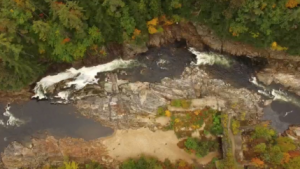
Figure 1. Aerial view of Livermore Falls. Upstream is to the left. Photo by Owen Ginty.
When we look back over time, there are a couple of significant dates. One of the more important is 1759, when the French were defeated in Quebec; borders became more established and this made settling the area of Holderness feel safer, and free of worry of having to be relocated in the future. This was the beginning of development in the area.
Then, in 1771 a gentleman named Moses Little who served as Moderator, selectman, and Justice of the Peace, bought thousands of acres around the falls and built a saw and grist mill. In 1773 the first mill was constructed along the west side of the river.In 1827 Judge Arthur Livermore acquired the property of Moses Little; and renamed the falls after himself.
Thirty-six years later in 1886 a company called Berlin, which is a company out of Connecticut who specializes in iron bridges, built a 263 ft. double span inverted deck trestle which sits 103 feet from the surface of the Pemigewasset River. The existing pieces are the only remnants of what is referred to as the “Pumpkin Seed Bridge,” refer to Figure 2.
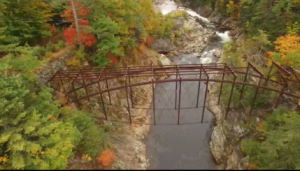
Figure 2. The 263 ft bridge for cars sits over the river just below the falls and was closed in 1959. Photo by Owen Ginty.
The bridge closed in 1959; the eastern side was cut loose and dropped making it no longer possible to cross, but this hasn’t stopped daredevils from using the bridge as a jumping platform, causing serious injury to some.
A series of mills for different purposes were built at the site and then were subsequently destroyed by fire or flooding. In the 1950’s the mill ceased operation. With the lack of upkeep the mill became a focal point for vandalism. A flood in 1973 washed away part of the mill, further destroying the structure. A dam and power house were taken out by flooding.
Eastman’s White Mountain Guide lists Livermore falls as “wild and romantic scenery”. A Holderness townscape study done by U Conn professors Rudy Favretti and John Alexopolis hailed Livermore Falls as a “priceless natural resource”.
The Wild and Scenic Rivers Act was passed by congress in 1968 to protect certain free-flowing rivers for recreation for current and future generations. The Act’s main purpose was to balance out the nation’s long-standing water resource development policy with river conservation policy. As development along the Pemi continued, a local group lobbied to have the headwaters of the Merrimack designated as a Wild and Scenic River. A study was commissioned and conducted in 1996, but surrounding towns including Plymouth, Campton, and Holderness voted against the designation, but much useful conservation data was collected, .
There was a proposal to build a hydroelectric power plant in 1988 although it was denied by the Federal Energy Regulation Commission after numerous hearings. A key reason for denying the proposal of the plant was that in times of high runoff it could cause flooding upstream 15 miles to North Woodstock.
The hydrology of the Pemi above Plymouth is interesting because there are no retention or flood control dams. Therefore gaging stations are important for alerting people to rising river levels. The first gaging station in NH is located downstream in Plymouth, NH. and another is upstream in Woodstock. Citizens can access real time discharge data to see how fast and high the river is flowing, or as is indicated in Figure 3, that the river is covered in ice: https://waterdata.usgs.gov/nh/nwis/uv?site_no=01076500.
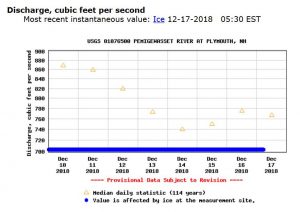
Figure 3. Discharge information from the USGS gaging station in Plymouth, NH, downstream from Livermore Falls, showing ice cover in December, 2018.
Resources
“Campton Historical Society .” Historical Sight Series, Livermore Falls, NH Historical Society, www.camptonhistorical.org/Livermore Falls marker flyer.pdf.
“Pemigewasset Wild and Scenic River Study.” Rivers.gov, New England System Support Office, Department of Interior , Mar. 1996, www.rivers.gov/documents/studies/pemigewasset-draft-study.pdf.
Ruell, David. “LIVERMORE FALLS GORGE: A TIMELINE.” LivermoreFalls.org, Campton Historical Society. http://livermorefalls.org/wp-content/uploads/Historic-Timeline-.pdf